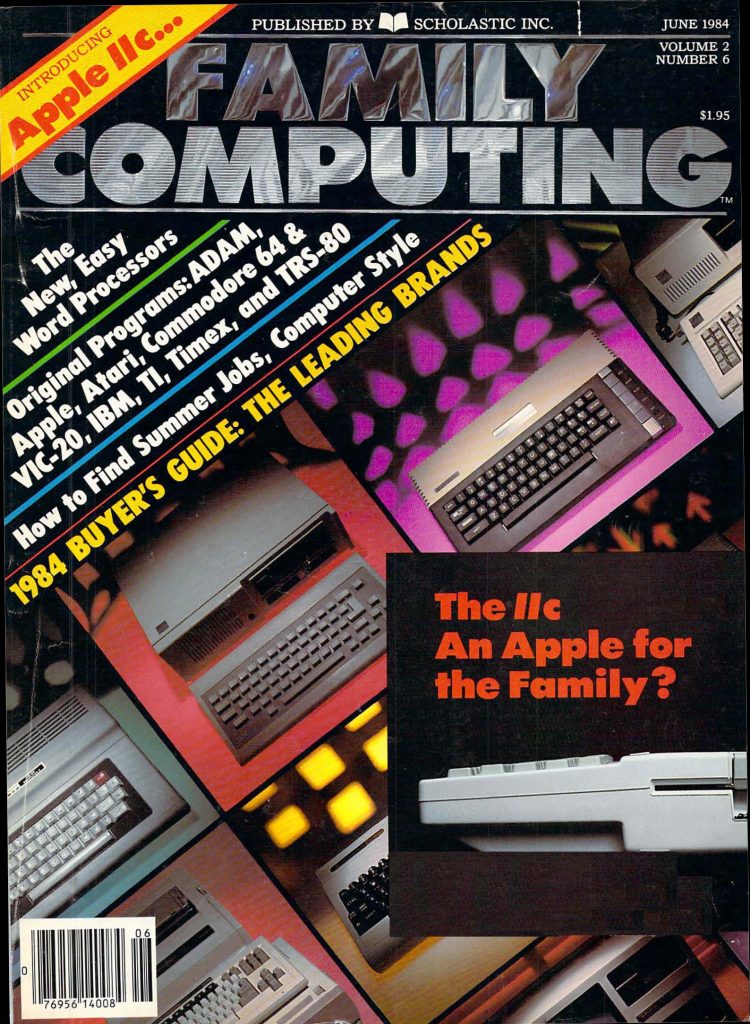Source: Family Computing – Issue Number 10 – June 1984
Family Computing was a 1980s U.S. computer magazine published by Scholastic, Inc. It covered all the major home computer platforms of the day including the Apple II series, Commodore Vic 20 and 64, Atari 8-bit family as well as the IBM PC and Apple Macintosh among others. The June 1984 issue includes:
Features
- The “Hard-Boiled” School of Software – An interview with Infocom’s revolutionary adventure-game designers., the creators of Zork, Starcross, and The Witness.
- Whistle While You Word Process – There’s a new crop of word-processing programs that are perfect for family use – they’re inexpensive and easy to operate. Inside…find out how they rate. Plus: How to Judge Word-Processing Software
- Looking For A Summer Job? – Ten ways to earn money with the help of your computer.
- A New-Age Mom-And-Pop Business – Many people dream of running a computer store. The Seran family of Colorado took the plunge. Plus: Starting A Computer Store – Tips From The Serans
- Five-Year-Old Authors – IBM’s Writing to Read System has kindergartners reading and writing as if they were born knowing how.
- Buyer’s Guide to Computers – A look at the 10 leading models for home use, with a comparison of prices, graphics capabilities, and other features.
- A Preview: Apple IIc – Apple heads for the home market with its new product: a sleek 7.5-pound transportable computer with a built-in disk drive.
Programming
- The Programmer – For enthusiasts of all levels.
- Beginner Programs – Print disk labels and create an original Father’s Day gift for your dad with programs for ADAM, Apple, Atari, Commodore, IBM, TI, Timex, and TRS-80 computers.
- Puzzle – Recipe for Disaster: Can you retrieve the stolen recipe in time for the culinary competition?
- Programming P.S. – Sorry, we goofed. Here are some corrections for programs from previous months, plus some program enhancements from readers.
- Reader-Written Program – Fishtank: Create a sea of tropical fish on your computer screen.
Products
- What’s In Store – Ten pages of product announcements and reviews.
- New Hardware Announcements – The latest in the field: the IBM Portable Computer; a new Kaypro 4; the Smart-Cable 817, a module that connects to the serial port on many computers; the MicroRam 64K Memory Board for the Atari 600XL; and Mikel’s serial interface for the Ti-99/4A.
- Software Guide – Quick takes on two dozen new and noteworthy programs.
- Software Reviews
Departments
- Editor’s Note
- Letters
- Behind The Screens – Keeping your Timex ticking; a programmer’s windfall; microfloppies; and more.
- Home-School Connection – Tomorrow’s VisiFarmers: In Ortonville, Minnesota, teenagers are applying what they learn in school about computers to help their parents run the family farm.
- Home Business – Keeping the Lincoln (Illinois) Log: The Strasmas tell how they run a national computer information service from their rec room.
- Computer Clinic – Questions from readers are answered.
- Games – Games People Play: The state of the art and a survey of your gaming habits.
- BASIC Booth – A monthly cartoon.
- Books
- The Primer – A reference guide that appears each month.
- Classified
- Advertisers’ Index
…and more!





